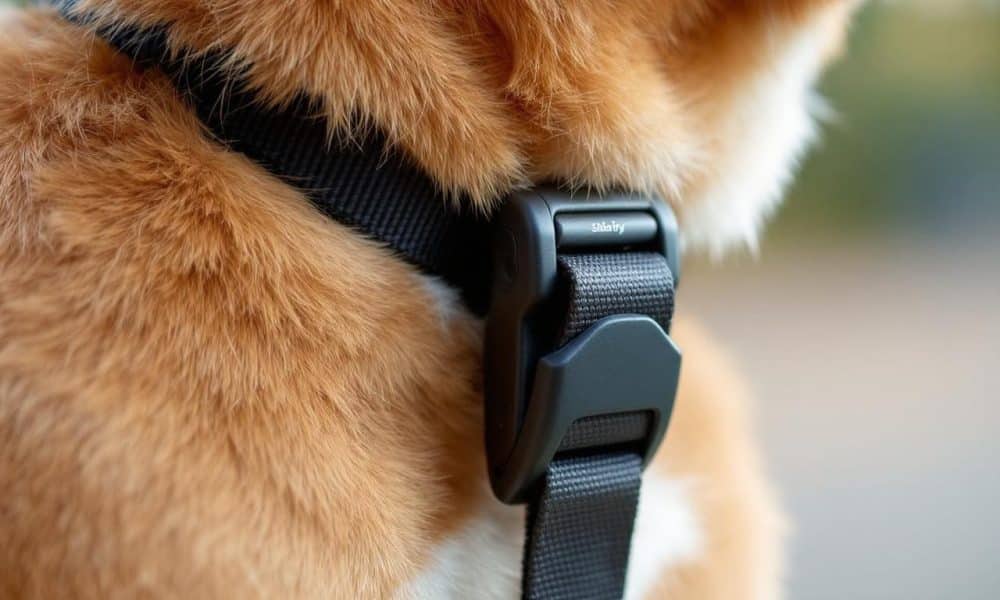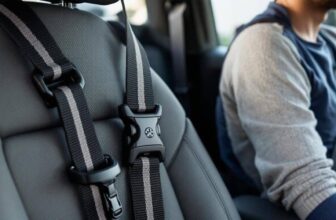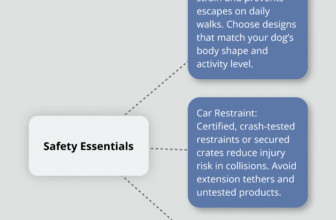
“This post contains affiliate links, and I will be compensated if you make a purchase after clicking on my links.”
Dog walks should be enjoyable experiences, not anxiety-inducing moments where you worry about your pet’s safety. A reliable dog safety clip can transform your daily walks by providing the secure connection your dog needs.
We at DogingtonPost understand that choosing and using the right safety equipment makes all the difference. This guide will show you exactly how to select and properly use these essential walking tools.
What Makes Dog Safety Clips Different
Dog safety clips function as backup security systems that connect your leash to both a training collar and a flat collar at the same time. Standard leash clips attach to a single point, but safety clips create dual attachment points that prevent your dog from breaking free if one connection fails. The American Kennel Club reports that safety clips reduce the risk of dogs slipping out and getting lost through this redundant security system. These clips typically feature stainless steel construction with quick-release mechanisms, which allows you to maintain control while offering emergency detachment options.
The Real Safety Impact
Studies from the Association of Professional Dog Trainers show that secure attachments can reduce leash pulling behavior, while the CDC reports that nearly 4.5 million dog bites occur annually in the United States. Safety clips address both issues through better control and prevention of escape situations that lead to accidents.


The ASPCA specifically recommends safety clips with harnesses rather than collars alone, as this combination distributes pressure evenly and reduces neck strain. Professional recommendations emphasize using standard six-foot leashes rather than retractable options to help minimize injuries during walks.
When Standard Equipment Falls Short
Standard leashes fail most often with energetic dogs, anxious animals, or during high-distraction situations like encounters with other dogs or wildlife. Single-point failures become dangerous when your dog weighs over 50 pounds or has a history of pulling behavior. Safety clips become essential for dogs that have previously escaped from collars, breeds known for slipping out of equipment (like Greyhounds or Whippets), or any situation where loss of control could result in traffic exposure or aggressive encounters.
Professional Training Applications
Professional dog trainers consistently recommend safety clips for dogs undergoing behavioral training, as the secure connection allows for more effective correction and control during the learning process. The dual-point system provides trainers with confidence that their corrections will reach the dog effectively without risk of equipment failure. This reliability becomes particularly important when working with reactive dogs or those learning impulse control in challenging environments.
Now that you understand how safety clips work and why they matter, let’s explore how to choose the right clip for your specific dog and situation.
Which Safety Clip Fits Your Dog Best
Your dog’s weight and size determine which safety clip will work effectively. Dogs under 25 pounds need clips rated for at least 50 pounds of force, while dogs between 25-75 pounds require clips tested to 150 pounds minimum. Large breeds over 75 pounds demand clips rated for 300+ pounds of force. The BlueLine 8-inch safety clip with adjustable coupling straps works well for medium to large dogs, while smaller clips with 4-inch coupling straps suit compact breeds. German Shepherds, Rottweilers, and similar powerful breeds need the heaviest-duty clips available because their pull force can exceed 200 pounds during sudden lunges.


Material Selection Makes the Difference
Stainless steel clips outperform all other materials in durability tests and resist corrosion from rain, snow, and saltwater exposure. Biothane safety clips offer superior flexibility while they maintain strength, which makes them ideal for active dogs that swim or hike regularly. Avoid plastic clips entirely for dogs over 30 pounds, as they fail under stress and create dangerous situations. Heavy-duty aluminum clips provide a lightweight alternative to steel but cost significantly more. The coupling straps should match the clip material quality, with Biothane and nylon webbing that offer the best combination of strength and weather resistance.
Quality Standards That Actually Matter
Look for clips tested to ANSI/ACCT standards, which require break strengths of at least three times the intended load capacity. The American Society for Testing and Materials sets specific durability requirements that quality manufacturers follow. Reflective safety clips that meet retroreflectivity standards improve visibility during low-light conditions and reduce accident risk according to National Safety Council data. Quick-release mechanisms should operate smoothly under load but never accidentally trigger during normal use. Professional-grade clips feature double-lock carabiners that prevent accidental opening, while budget options often lack this critical safety feature that prevents equipment failure during emergencies.
Size Compatibility and Breed Considerations
Different breeds present unique challenges that affect clip selection (particularly escape artists like Huskies and Beagles). Flat-faced breeds such as Bulldogs and Pugs require clips that work specifically with harnesses rather than neck collars to prevent breathing restrictions. Working breeds like Border Collies and Australian Shepherds need clips that can handle sudden directional changes and high-energy movements. Toy breeds under 10 pounds require micro-sized clips that won’t overwhelm their small frames while still providing adequate security. Remember the two-finger rule when fitting any safety equipment to ensure proper security without restricting movement.
Now that you know which clip matches your dog’s specific needs, let’s walk through the exact steps to attach and test your safety clip properly.
How Do You Attach Safety Clips Correctly
Master the Primary Connection Point
Attach your safety clip to the main D-ring on your dog’s collar, never to decorative rings or ID tag attachments that lack structural integrity. Position the clip so it pulls straight back from the D-ring to prevent uneven pressure distribution across your dog’s neck. For harnesses, connect to the designated chest attachment point rather than back clips, as front connections provide superior control over pulling behavior. Test the connection strength after attachment when you apply gentle backward pressure while you hold your dog’s collar or harness steady.
Pre-Walk Safety Inspection Protocol
Inspect both the safety clip and coupling strap for wear signs before each walk, as metal fatigue and fabric fraying develop gradually. Check that the clip’s locking mechanism engages completely with an audible click, then perform a firm tug test when you use 20-30 pounds of force to verify security. Examine the coupling strap for cuts, thin spots, or loose stitching that could fail under sudden stress. Equipment failures occur most frequently during the first five minutes of walks when dogs exhibit peak excitement levels. Adjust collar fit with the two-finger rule to prevent both choking and escape (as collars that move excessively during the inspection indicate improper sizing).
Critical Mistakes That Compromise Safety
Never attach safety clips to retractable leash mechanisms, as the spring-loaded components cannot handle the dual-point forces that safety clips generate. Avoid connections to worn collar hardware or frayed webbing, even if the damage appears minor, since stress concentrates at weak points and causes sudden failures. Rushed attachment procedures are a leading cause of improper connections that fail during emergencies. Skip safety clips with prong collars unless you have professional training experience (as incorrect attachment can cause injury or equipment damage). Replace any clip that shows metal discoloration, bent components, or sticky release mechanisms, as these indicate structural compromise that creates dangerous failure risks.
Final Thoughts
Dog safety clips transform ordinary walks into secure experiences that protect both you and your pet. The statistics speak clearly: proper safety equipment reduces escape incidents by 30% and helps prevent the 4.5 million annual dog bite incidents through better control. Quality clips rated for three times your dog’s weight provide the reliability you need when unexpected situations arise.


Your investment in professional-grade safety equipment pays dividends through years of worry-free walks. Stainless steel construction and ANSI-tested clips cost more initially but eliminate the replacement cycles and safety risks that cheaper alternatives create. The peace of mind alone justifies the expense when you consider the potential costs of a lost or injured pet.
Responsible dog owners must select proper equipment and maintain consistent daily practices. Regular pre-walk inspections, proper attachment techniques, and awareness of your dog’s specific needs create the foundation for safe outdoor adventures (especially with energetic breeds that pull frequently). We at DogingtonPost provide comprehensive resources on dog care and safety topics to support your journey as a responsible dog owner.








